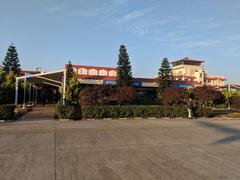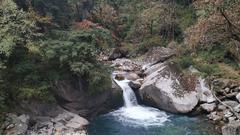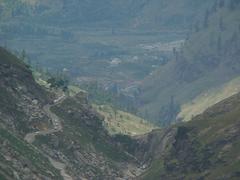Koldam Dam Visiting Hours, Tickets, and Travel Guide – Himachal Pradesh Historical Site
Date: 04/07/2025
Introduction: Koldam Dam’s Significance in Himachal Pradesh
Koldam Dam, located on the Satluj River in the Bilaspur district of Himachal Pradesh, stands as a testament to modern hydroelectric engineering and environmental stewardship. As one of India’s tallest rockfill dams, rising to 167 meters, it plays a vital role in generating 800 MW of clean electricity for northern India and in regulating silt flow to extend the operational life of the Bhakra Dam downstream. The dam’s striking structure, set amidst the Himalayan foothills, has made it an emerging attraction for tourists interested in nature, history, and sustainable development.
This comprehensive guide details everything you need to know about visiting Koldam Dam, including historical background, visiting hours, ticketing information, accessibility, travel tips, and nearby attractions. Whether you are a history buff, an engineering enthusiast, or a nature lover, Koldam Dam offers a unique experience blending technology, culture, and natural beauty. For official updates and visitor resources, refer to the NTPC Koldam Dam website and the Himachal Pradesh Tourism official site.
Table of Contents
- Introduction
- Historical Background
- Construction Challenges
- Visitor Information
- Scenic Views and Photography
- Activities and Experiences
- Safety and Security
- Environmental and Cultural Sensitivity
- Accommodation and Dining
- Accessibility for Differently-Abled Visitors
- Local Attractions and Extensions
- Practical Tips
- Frequently Asked Questions (FAQ)
- Responsible Tourism Guidelines
- Conclusion
- References & Useful Links
Historical Background
Early Planning and Strategic Importance
The Koldam Hydroelectric Power Project was conceptualized by the National Thermal Power Corporation (NTPC) to address the rising energy needs of northern India and to promote sustainable energy. Inaugurated in 2000, with construction starting in 2004, Koldam Dam became NTPC’s first hydroelectric venture. Besides generating power, the dam is integral for controlling silt in the Satluj River, helping to prolong the operational life of the Bhakra Dam and enhance regional water management.
Design and Technical Specifications
Koldam Dam is a rock and gravel fill embankment with a central clay core. Its impressive dimensions—167 meters in height and 474 meters in length—make it one of India’s tallest embankment dams. The project includes four 200 MW Francis turbines, surface powerhouse, a sophisticated spillway system with six radial gates, two diversion tunnels, and a unique bottom outlet for controlled reservoir filling and silt management.
Construction Challenges
Geological and Environmental Complexities
Situated in the seismically active and geologically complex Himalayan region, Koldam Dam’s construction demanded advanced engineering solutions. High silt loads, unpredictable weather, and seismic risks necessitated detailed surveys, adaptive construction methods, and innovative environmental management practices.
Engineering and Social Considerations
Diversion of the Satluj River, deep foundation work, and the integration of robust flood management systems were technical milestones. The project also involved relocating local communities with fair compensation and implementing measures to protect biodiversity and minimize ecological disruption.
Visitor Information
Visiting Hours
- Standard Hours: 8:00 AM to 6:00 PM daily (public viewing areas only).
- Best Time to Visit: Spring (March–June) and Autumn (September–November) for pleasant weather and scenic beauty.
Tickets and Entry Fees
- Entry Fee: Free for all visitors at public viewpoints.
- Guided Tours: Official guided tours are limited, but may be arranged through local tourism offices or during special events. Check with Himachal Pradesh Tourism.
Accessibility
- By Road: Approximately 18–30 km from Bilaspur town; accessible via well-maintained highways and local roads.
- By Rail: Nearest major station is Kiratpur Sahib (about 40 km away).
- By Air: Chandigarh Airport (approx. 110–130 km).
Parking is available near the main viewing points. Some terrain may be uneven, so comfortable footwear is recommended.
Facilities
- Amenities: Restrooms and small eateries are available near the highway. Limited amenities onsite—carry water and snacks.
- Safety: Follow all instructions from security personnel. Certain areas are restricted for operational and security reasons.
Scenic Views and Photography
Public viewpoints along the Chandigarh–Manali Highway and nearby hills offer excellent vistas of the dam and reservoir, especially at sunrise and sunset. The monsoon season adds dramatic clouds and lush greenery, making it a photographer’s delight. Drone usage and professional photography may require prior permission.
Activities and Experiences
- Sightseeing: Admire the dam’s massive structure and panoramic reservoir.
- Nature Walks: Explore nearby hills and forested areas for short hikes.
- Picnicking: Utilize designated spots along the highway and near the reservoir.
- Birdwatching: Spot local and migratory birds, especially during winter.
- Educational Visits: Engineering and environmental study groups can arrange informative tours with local authorities.
Safety and Security
Due to the dam’s strategic significance, expect regular security checks. Swimming, boating, and fishing are generally prohibited for safety reasons. During monsoon, be cautious about slippery paths and potential landslides.
Environmental and Cultural Sensitivity
Respect the local environment by minimizing noise and litter. Engage with communities respectfully and honor local customs. The region is rich in culture and biodiversity; responsible tourism ensures its preservation.
Accommodation and Dining
There are no accommodations at the dam site. Bilaspur town (18 km away) offers hotels, guesthouses, and homestays for various budgets. Roadside eateries serve North Indian cuisine; Bilaspur provides more dining options.
Accessibility for Differently-Abled Visitors
The hilly terrain and limited infrastructure make accessibility challenging for those with mobility issues. Main viewpoints can be reached by car, but ramps and dedicated facilities are lacking. Visitors needing assistance should plan accordingly.
Local Attractions and Extensions
- Gobind Sagar Lake: Scenic boating and birdwatching at the Bhakra Dam reservoir (approx. 30 km).
- Bilaspur Town: Explore temples, markets, and local cuisine.
- Naina Devi Temple: Revered pilgrimage destination accessible by trek or cable car.
- Majathal Wildlife Sanctuary: Ideal for wildlife and bird enthusiasts.
- Tatta Pani Hot Springs: Renowned for therapeutic benefits.
Practical Tips
- Wear comfortable footwear and carry a light jacket.
- Bring essentials like water, sunscreen, and a hat.
- Retain all waste and dispose of it responsibly.
- Private vehicles offer the most flexibility; taxis and buses also available.
- Mobile coverage is adequate, but internet speeds may be slow.
Frequently Asked Questions (FAQ)
Q: What are Koldam Dam’s visiting hours?
A: Public viewpoints are open from 8:00 AM to 6:00 PM daily.
Q: Is there an entry fee?
A: No, entry is free at public areas.
Q: Are guided tours available?
A: Limited; check with Himachal Pradesh Tourism for special arrangements.
Q: Is Koldam Dam accessible for differently-abled visitors?
A: Accessibility is limited; main viewpoints are reachable by car, but terrain may be uneven.
Q: When is the best time to visit?
A: March–June and September–November are ideal for pleasant weather and vibrant scenery.
Responsible Tourism Guidelines
- Obey all posted signage and security regulations.
- Avoid restricted zones and operational areas.
- Support local communities by purchasing handicrafts and dining locally.
- Seek permission before photographing people or property.
- Leave no trace—carry all waste with you.
Conclusion
Koldam Dam combines the marvels of engineering with the tranquility of the Himalayas, offering visitors an educational and scenic getaway. While operational zones remain off-limits, the accessible viewpoints, nature walks, and nearby attractions make it a rewarding destination. Plan your visit with respect for local customs and the environment, and take advantage of the many opportunities for photography, learning, and relaxation.
For the latest updates, visitor advisories, and special events, download the Audiala app, follow official tourism channels, and prepare to explore one of northern India’s hydroelectric landmarks. Additional information is available at the NTPC Koldam Dam website and the Himachal Pradesh Tourism portal.
References & Useful Links
- NTPC Koldam Dam official site
- Himachal Pradesh Tourism Official Site
- Bilaspur District Information
- Koldam Dam Technical Details
- Top 6 Dams in Himachal Pradesh – Himachal Pradesh Times
- Places to Visit in Himachal Pradesh in July – TravelTriangle



